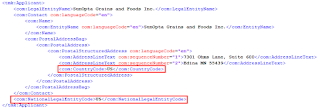This post presents an overview of CIPO’s trademark .xml data from a continental and sub-continental regional standpoint.
CIPO’s trademark .xml files include country-specific address and nationality details for mark owners. Country-specific address details are also provided for trademark agents, opponents, section 45 requesters, etc. For example, on the right is the <tmk:Applicant> element from CIPO’s .xml file for application no. 2104966. I have red-boxed the <com:CountryCode> element portion of the applicant’s postal address and the <com:NationalLegalEntityCode> element, both of which encapsulate the 2-letter country code US (click to enlarge the image). If such details are stored in a database, the database can be queried to derive country-specific analytical information, e.g. “How many Swiss-resident mark owners filed applications covering Nice Class 3 in 2020?”, etc.
As useful as such country-specific analytics might be, it is sometimes desirable to take a broader view. This can be done via the M49 geographical regions developed by the United Nations Statistics Division. M49 regional assignments are currently provided for 249 countries or areas, e.g. Antarctica, Saint Pierre and Miquelon, etc. Countries or areas are assigned to continental regions, which are subdivided into sub-regions and intermediary regions. For example, the African continent has 2 sub-regions: Northern Africa and Sub-Saharan Africa. Northern Africa has no intermediate regions, but Sub-Saharan Africa has 4: Eastern Africa, Middle Africa, Southern Africa and Western Africa. Accordingly, Kenya is in Africa / Sub-Saharan Africa / Eastern Africa. Mexico is in Americas / Latin America and the Caribbean / Central America. And so on.
The UNSD provides a downloadable spreadsheet containing, for each country or area, the M49 code, the region, sub-region and intermediate region names & codes, the ISO alpha-2 country code (e.g. US), the ISO alpha-3 country code (e.g. USA) and more. CIPO uses ISO alpha-2 country codes to populate the <com:CountryCode> and <com:NationalLegalEntityCode> elements. Accordingly, if the spreadsheet’s details are loaded into a table within the aforementioned database, then the database can be queried by joining the ISO alpha-2 country codes in that table with the corresponding 2-letter country codes extracted from the <com:CountryCode> and <com:NationalLegalEntityCode> elements. This facilitates derivation of a variety of geographical supranational result sets, as shown in the examples below which are based on CIPO’s data as of 17 May 2021.
The first example gives a breakdown of post-CIF filings by geographical region, with Madrid and non-Madrid cases broken out separately:
The second example gives a breakdown of Geographical Indications by geographical region:






